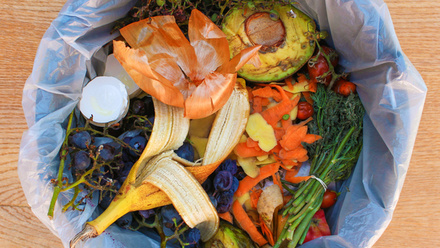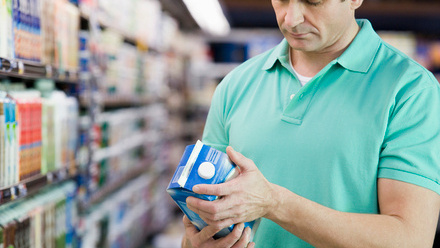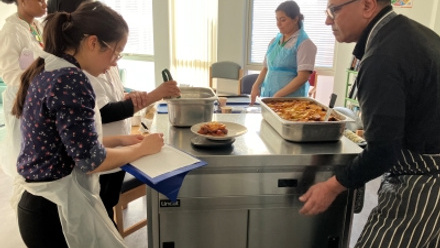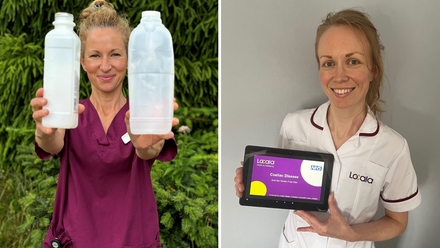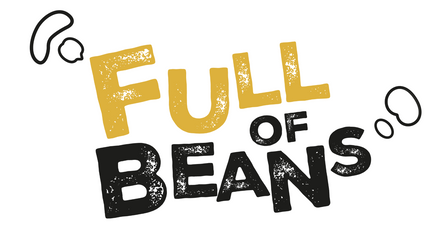Dietitians are very familiar with using food labels to support clients to find foods suitable for their health and nutrition goals. But how many understand how to check whether food products are produced in a way that benefits the environment?
Retailers and food manufacturers are members of multiple schemes and industry benchmarking projects that support their environmental and ethical commitments in the widest sense. This may be by joining schemes like the Plastic Pact or the Carbon Trust standards.
Many also commit to reducing carbon emissions at a food systems level. For example, ‘regenerative farming’ practices like this example from BDA corporate members Danone can restore soil health so that can draw carbon from the atmosphere, strengthening biodiversity and retain more water.
For consumers, various logos of UK standards and kitemarks like Red Tractor, MSC, Organic, British Lion, RSPCA Assured, Fairtrade are visible on pack. Most are related to the production in some way so may be perceived as adding an environmental message and unintentionally create a ‘greenwash’ effect for the product.
When we worked on the Sustainable Baskets initiative, we mapped these in some detail to understand the extent to which environmental sustainability of the produce was considered in the standards. We found that they generally focus on social impact, food traceability and animal welfare.
So, what is happening to give consumers and nutrition experts more specific product information on the actual carbon footprint of individual products – and what about initiatives to create a single ‘eco-label’?
Are there any climate-specific labels I can look for?
In June, the European Commission called for a “European eco-score” to inform consumers about the ecological impact of different products. Some in the UK government, including Labour MP Luke Pollard, Shadow Secretary of State for environment, food and rural affairs, want to see clearer labelling on carbon and environmental credentials so consumers can back the brands and products doing the right thing by our planet.
Single scores are reductive by their very nature and most approaches could be criticised for oversimplification in a such a complex picture, but as we know from nutrition labelling each food has positive and less healthy nutrients so the label must be clear to provide actionable information.
Even mature schemes like palm oil labelling experience ongoing debate. RSPO has been criticised by campaign groups like Greenpeace for not going far enough, but the issues of this single ingredient are multifactoral as explained in our FAQ on its environmental impacts vs those of animal fats.
Here we discuss some mainstream schemes:
Carbon footprinting
Carbon footprinting is considered by many to be the most useful singular metric currently to assess and compare product sustainability across different food types. Access to quality datasets has been an issue in the past but there is an increasing amount of robust data available and discussions are increasing among food manufacturers and retailers.
Although it can’t capture other aspects of sustainability which are also important considerations for dietary changes e.g. the impact of production methods on land, soil and water systems; the health and economic costs of food production; the level of waste across the value chain; welfare standards, it does offer a metric for people to work to.
Carbon footprinting in practice:
One example is Quorn Foods who have been footprinting their core products and using third party accreditation for nearly 10 years.
The carbon footprint for Quorn Mince and Pieces is calculated using primary data from 'Farm to Shop' which accounts for all greenhouse gases emitted from the production of raw materials up until the supermarket, including growing of ingredients, manufacture, packaging, storage and transportation.
In our Sustainable Eats project with Quorn Foods, we worked together to calculate carbon footprints of whole recipes because consumers will find limited information on pack currently so working out your impact across a whole diet is challenging for an individual. The team wanted to demonstrate the carbon footprint metrics in a relatable way within the resource and identified that an average daily figure per person for food is 2.8 kg[1]. This figure from a National Diet and Nutrition survey report also included a target to reduce daily emissions by 1.78kg per person.
To further understand the complexities of this approach, our Sustainable Eats project methodology may help.
EU Ecolabel
The UK has ceased to participate in the Ecolabel scheme since Brexit. It is a voluntary scheme, which means that producers, importers and retailers can choose to apply for the label for their products.
They take a life cycle approach which means starting with extraction – the mining or cultivation of the raw materials, such as cotton (for textiles) or wood (for paper products). It continues with manufacturing and packaging, distribution, use and finally the “end of life” stage, when the product is disposed of or recycled.
Eco-Score
Developed in France by a consortium of food tech businesses, Eco-Score is a front of pack labelling initiative that gives a score out of 100 to individual products which is then adjusted for additional good and less positive features to give a colour coded rating of A to E. It is being piloted by Lidl in Germany, although they stress they are also open to other eco labelling initiatives.
It measures the environmental impacts of a product’s production, packaging and transport, but does not look specifically at biodiversity, animal welfare or pesticides.
Foundation Earth
Foundation Earth – a new NGO made up of international food giants, supermarket chains, the European food innovation body EIT Food, as well as food and environment experts – announced the launch of a pilot project to print an eco-score on selected product packages as of this month.
The Foundation Earth eco-score will rate products from A+ to G according to a method developed by Britain’s Oxford University with the support of WWF. An example label for red lentils shows typical carbon emissions per 100g, water usage and pollution, and a biodiversity score.
The calculation will also consider the environmental impacts of farming, processing, packaging and transportation. For each of these life cycle stages, the impact will be measured in terms of carbon emissions, plus the quantity of water used, the water pollution generated and the impact on biodiversity.
In parallel to the pilot, a Nestlé-sponsored R&D programme is destined to prepare Foundation Earth for a pan-European launch of the label in 2022.
CLEAR manifesto
The Pasture Fed Livestock Association is leading a consortium calling for the development of clear accessible food labels that identify method of production. They say this will respond to the consumer’s desire for greater transparency over how their food is produced.
The PFLA has always argued that current labelling regulations, which mean that the term ‘grass-fed’ can be used to describe meat and dairy products that are ‘predominantly fed on grass, ie which can be just 51% grass-fed, are misleading.
So, what questions can we ask ourselves when buying food?
The picture is complex. There are dozens of schemes under development and until one is validated and accepted widely, mainstream side by side comparisons at the point of purchase for consumers and nutrition experts will be impossible.
Meanwhile, it can be helpful to look at this by category so we have broken this down to map against the recommendations in the One Blue Dot reference guide:
Red Meat
|
Getting started – Where is it from? |
Moving on – How has it been produced? |
|
The Red Tractor logo will tell you whether it has been farmed, processed and packed in the UK, which generally implies a lower environmental footprint due to less travel. Eating less popular meats such as mutton and hogget mean that we also benefit from wool as a by-product. Local wild game such as venison can be significantly better than other farmed red meats: Deer Commission for Scotland conducted an analysis which indicates that the carbon footprint of venison is 38% lower than beef and 49% lower than lamb. |
The Pasture-Fed Livestock Association’s Pasture for Life label* is a guarantee that animals that have only eaten grass (no grains). This has a lower carbon footprint than cereal and soya fed farming.
|
Plant Proteins
|
Getting started – Where is it from? |
Moving on – How has it been produced? |
|
Many legumes and beans are imported to the UK from Canada, Italy, France and India although there is some British production led by brands like Hodmedods. Despite transport distances, these foods have a long shelf life and provide good nutrition at an affordable cost. Much of the soya foods consumed directly by humans in the UK, are made with beans sourced from Europe and Canada – unlike the genetically modified soya grown for animal feed in Brazil, Argentina and China. BDA corporate members Alpro do not source soya from the Amazon. 60% of the soya beans they use are grown in France, Belgium and the Netherlands with the rest coming from Canada (transported by sea for a lighter carbon footprint).
|
Soya crops themselves are no more environmentally damaging to grow than any other bean – and in fact they may be less so as they have a more complete nutritional composition. The fact that soya bean cultivation is causing deforestation across the globe is often used as a criticism of the crop, but only a small amount of production is for humans, with the vast majority being genetically modified for animal feed. ooking for the Responsible Soy logo on pack or checking membership for your favourite products is a good way to understand how it has been produced. |
Fish
|
Getting started – Where is it from? |
Moving on – How has it been produced? |
|
Sustainable fish sources are those that can continue indefinitely and do not have an impact on the wider ocean ecosystem. The Marine Conservation Society (MCS) maintains a “Good Fish Guide” which can be used to identify which fish and shellfish species are most at risk and which are most sustainable.
|
The way fisheries are managed is crucial to their environmental impacts. A ‘certified fishery’ has received certification from the Marine Stewardship Council (MSC). Additionally for farmed fish, the Aquaculture Stewardship Council (ASC) logo represents sustainably farmed fish. |
Dairy
|
Getting started – Where is it from? |
Moving on – How has it been produced? |
|
The British Dairy industry is collaborating on sustainability issues. Dairy UK, ADHB and NFU have put in place a UK Roadmap to reduce the environmental impact of each pint of milk produced, from water use to packaging.
Most milk and cheese products have a country of origin label on them, and the NFU’s Back British Farming icon can be seen on many local products. Red Tractor also tells us the product is produced in Britain and meets various welfare and production standards.
|
Dairy foods are affordable, nutritious and popular source of essential nutrients in the UK diet. We discuss ‘moderation’ of dairy in our One Blue Dot reference guide. The important nutrients from dairy foods may be best accessed via milk and lower fat dairy foods like yoghurt, than higher fat, more greenhouse gas emission intense products like cheese, ice cream and desserts.
|
Potatoes, rice, grains
|
Getting started – Where is it from? |
Moving on – How has it been produced? |
|
The British Dairy industry is collaborating on sustainability issues. Dairy UK, ADHB and NFU have put in place a UK Roadmap to reduce the environmental impact of each pint of milk produced, from water use to packaging.
Most milk and cheese products have a country of origin label on them, and the NFU’s Back British Farming icon can be seen on many local products.
Red Tractor also tells us the product is produced in Britain and meets various welfare and production standards.
|
Dairy foods are affordable, nutritious and popular source of essential nutrients in the UK diet.
We discuss ‘moderation’ of dairy in our One Blue Dot reference guide. The important nutrients from dairy foods may be best accessed via milk and lower fat dairy foods like yoghurt, than higher fat, more greenhouse gas emission intense products like cheese, ice cream and desserts.
|
Fruit and vegetables
|
Getting started – Where is it from? |
Moving on – How has it been produced? |
|
Again, look for Red Tractor logos in mainstream retailers or visit local markets which are likely to also have more seasonal and local produce available, and may not have travelled so far. Transport is important as food air miles can have many times the carbon footprint of miles of transportation by sea. If fruit and vegetables aren’t in season when you buy them, try to find out if they have been flown in or grown locally in a hothouse heated by fossil fuels. Remember tinned and frozen count too and aren’t so perishable.
|
Looking at how produce is grown can help you understand how the producer cares for the soil and supports wildlife - for example if they use rotations of different crops and livestock rather than monocultures. Foods with an Organic label means than no pesticides and artificial fertilisers have been used. This can mean that farmers focus on crop rotation, rewilding or animal grazing instead. All of this improves soil quality.
|
Drinks Packaging
|
Getting started – Where is it from? |
Moving on – How has it been produced? |
|
If you choose to buy a drink in a bottle, the packaging is the main consideration. So, look for 100% recyclable packaging (whether glass, cans or PET plastic). Tetrapak-type packaging isn’t readily recyclable from kerbside collections so needs to be taken to specialist collection points. Look out for Deposit Return Schemes in Scotland from 2022. |
Increasing numbers of PET plastic bottles are made with recycled content, requiring less virgin PET plastic. Some drinks manufacturers state the % on their packaging and have committed to a specific date when all packaging will use 100% recycled materials to support a completely circular economy for the plastic. For example Volvic, part of BDA corporate member Danone, is working towards 2025 Clear plastic packaging is also more easily recyclable – which is why you won’t commonly see sparkling water in green plastic bottles now. |
Food Waste
To reduce your food waste, know your dates:
‘Best before’ refers to quality: your food will be at its best before the date given. After this date, it might not be at its best, but it will still be safe to eat. Use your senses to make a judgement.
‘Use by’ refers to safety: you must not eat food past the ‘use by’ date. Food may appear perfectly fine to eat, but could still lead to food poisoning and you should not eat food after this date - even if it looks and smells OK. However, you can freeze food right up to and including the ‘use by’ date.
‘Display until/sell by’: These dates are for the retailers – not us at home so you don’t need to worry about these.
Overconsumption
Another key question for healthy people who have choice about their food and eating patterns – do I need to buy this?
For example, breastfeeding is clearly the most sustainable way of feeding an infant. And huge salad bags which are likely to perish in our fridge may not be a better option than some frozen spinach.
The discretionary foods in the ‘eat less often’ section of the Eat Well Guide make up too much of a typical shopping basket, so for many of us, sticking to the right amount of the healthy core staples as seen in the UK dietary model is a good way to protect our health as well as the planet.
[1] Reynolds (2019) ‘Healthy and sustainable diets that meet greenhouse gas emission reduction targets and are affordable for different income groups in the UK’


